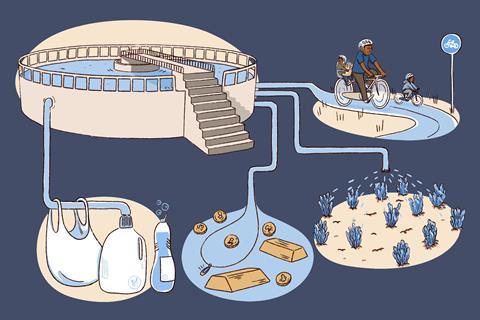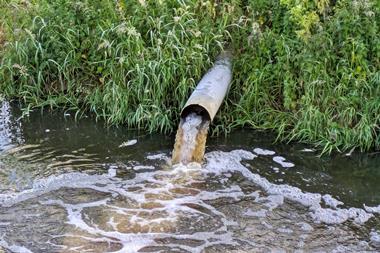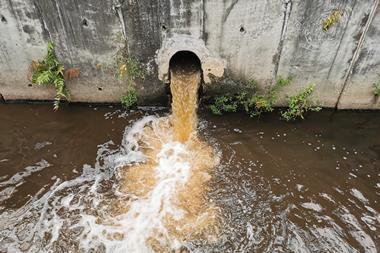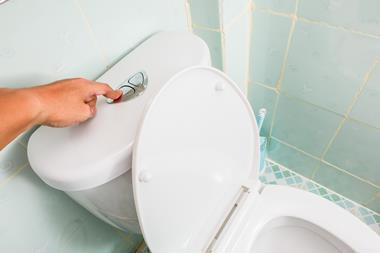An eye-opening visit to a waste water treatment works uncovers the surprising value in sewage. Hayley Bennett reports
It’s Monday morning and at a water treatment works raw sewage pours in from the nearby town of Redditch, UK. There are two pipes, one from the town and another smaller one from local villages. Human excrement drifts peacefully by. From above, the smell is not as bad as you’d imagine, but there’s a definite hum. To the left, a red skip collects everything larger than about a pencil’s width. The skip is full of plastic, sanitary ware, baby wipes and grit that has washed in off the roads. This is the ‘dirty end’ of the plant, Severn Trent’s Pete Vale says with a smile, though he’s not joking. There’s nothing quite like viewing the contents of 90,000 people’s toilets to bring you face to face with humanity.
The water industry has an interest in the circular management of wastewater, but the market isn’t ready
Francesco Fatone, Marche Polytechnic University, Italy
The waste water and most of the processes to treat it here at Spernal Wastewater Treatment Plant are typical of a medium-sized treatment works. Pondweed sits on top of the primary settling tanks, and the lanes of activated sludge rapidly bubble, as microbes busily break down the organic matter. In the background, in four concrete tanks tall enough to be visible a couple of miles down the road, biogas is being produced from the thickened sludge collected from these two processes. The ‘clean end’ is a short trudge away, at the heart of the plant. Here, something new and exciting is emerging. Something with the potential to turn the whole concept of waste water on its head.
The bottom line
Right now, it looks like nothing more than a clean slab of concrete with a couple of large tanks sitting on it. Construction workers are still on site, finishing off the access routes. But for Vale, who is the water company’s technical lead for innovation, it represents much more. ‘This is our new test bed,’ he says, explaining that the concrete slab is the current focus of Severn Trent’s efforts to turn its sewage treatment plants into ‘resource recovery factories’. Here, the company will experiment with a raft of technologies designed to extract chemical energy and nutrients such as phosphorus and nitrogen, plus, if everything goes well, cellulose, biodegradable plastics and even proteins. According to Vale, the building of this test bed signals the start of a step change for Severn Trent. ‘We’re going to trial new technologies that will hopefully shift us from the traditional way of just treating wastewater to viewing it as a valuable resource and recovering what we can,’ he explains.
It’s not just a pipe dream. Energy recovery is already commonplace at sewage plants in the UK and across Europe, and now water treatment companies are looking seriously at other solutions for making their industry more cost- and carbon-efficient. Materials recovery feeds directly into ideas about the circular economies of the future, but it’s also another way of improving the bottom line.
SMART-Plant, a European research project that Severn Trent is heavily involved with, focuses on getting some of the most promising recovery processes into treatment plants on the back of energy-saving technologies. ‘We’re applying technologies that can improve energy efficiency, so they have immediate benefit, and in addition you can recover materials,’ says chemical engineer Francesco Fatone, from Marche Polytechnic University in Ancona, Italy, who coordinates the project. ‘Because at the moment, yes, [the water industry] has interest in being ready for the circular management of wastewater, but as the market is not ready, we need another driver.’ The project has so far set up demonstration sites at six different waste water treatment plants across Europe, from Israel to the Netherlands. One pilot at a plant in Carbonera, Italy, currently produces 300g of phosphorus in the form of struvite (magnesium ammonium phosphate) and 1 kg of polyhydroxyalkanoates (PHAs) – ingredients for making biodegradable plastics – per day, whilst making energy savings of around 20%. The recovered struvite can be used as fertiliser, but removing it also benefits water companies because it’s a major cause of scaling in water pipes.
Extracting the P
Meanwhile, at a pilot plant at Cranfield University in the UK – sourcing sewage directly from the university’s larger treatment works – another SMART-Plant solution is recovering phosphorus, not as struvite, but as calcium phosphate. According to Ana Soares, a senior lecturer in biological engineering, it’s cheaper to recover it this way. The technology she uses is adapted from commercial ion exchangers used to remove arsenic from contaminated water and is due to be installed on Severn Trent’s new test bed this year. As Soares explains, it uses beads covered in iron nanoparticles to pluck the phosphorus from the wastewater.1 ‘We spotted that this media contains iron, and iron has a high affinity for phosphorus,’ Soares says. ‘So we pass the waste water through a bed full of this media, the phosphorus binds with the iron nanoparticles and we can selectively remove the phosphorus.’ To get the phosphorus out, they add sodium hydroxide to get it to unbind, followed by calcium hydroxide to precipitate it as calcium phosphate.

For a long time, phosphorus has been viewed as a pollutant because of its damaging effects on waterways.2 All treatment plants have to keep the amount they send back out to the environment within strict limits. But they can do this simply by dosing the water with iron to precipitate it – for removal, not recovery. So is there really enough phosphorus in waste water to make recovery technologies a sound investment? Severn Trent will find out, but Vale reckons there is around 8–10mg per litre in sewage, half of which comes from human waste. ‘So relatively low concentrations,’ he admits. ‘However, if you think of the high flows … that’s quite significant.’ At a rough guess, Vale suggests there could be enough in UK sewage treatment plants to supply close to half of what is imported as fertiliser. The Cranfield process would recover it in the same form – calcium phosphate – as it’s found in phosphate-rich rock (apatite) in countries like China and Morocco. Such minerals are, of course, depleting and the UK has none of its own reserves.
The Spernal test bed will experiment with phosphorus and nitrogen recovery – using a second ion exchange technology to recover nitrogen – in combination with an anaerobic membrane bioreactor that generates biogas.3 Standing in front of his empty slab, Vale tries to envisage how this will look. ‘The main biological reactor won’t look too dissimilar to the activated sludge,’ he says, indicating the aerated tanks we saw bubbling away earlier. ‘Probably in a taller tank. But rather than blow air into it, you just have the sewage coming in at the bottom and bacteria which are anaerobic rather than aerobic. Your biogas comes off the top and your effluent exits.’ Not needing to blow air in saves energy and money, but as anaerobic digestion works quite slowly in colder climates, the membrane is necessary to retain all the bacteria in the reactor. However, this membrane doesn’t filter out phosphorus or nitrogen, so they can be recovered afterwards.
Flush and flex
Nutrients are just the starting point for materials recovery, though, and Spernal’s test bed is designed to trial as many as 12 different technologies at once. During our tour, Vale stops next to some newly installed pumps to explain how the whole thing works. The flow is intercepted either before or after it enters the settling tanks and the new pumps deliver it to the test bed to undergo treatment in one or a combination of test processes. The treated water can then be returned to the main works for traditional processing. He describes it as a ‘plug and play’ system that taps into the main sewage streams.
So with all this flexibility, what else could they plug in? Vale thinks cellulose recovery is likely in the near future. Although Severn Trent doesn’t have firm plans just yet, it does have links with CirTec, a Dutch company recovering cellulose from the toilet paper in sewage (both are SMART-Plant partners.) In 2017, CirTec opened the first sewage to cellulose facility, in Warmenhuizen, the Netherlands.
At the Warmenhuizen plant, fibres of used toilet paper are separated from the liquid by finer than normal sieving. This relatively simple technology would add an extra layer of screening on top of the coarser one dumping out into Spernal’s big red skip. As technical director Coos Wessels explains, the CirTec process emerged from attempts to increase biogas production by filtering out and using more of the solid matter from sewage. ‘We put [the solid part] under the microscope and, looking at it, there was a lot of cellulose in this material we were screening,’ he says. ‘And cellulose is a valuable product.’ The global cellulose fibre market is valued at over $21 billion (£17 billion) and it’s growing, as demand from the textiles industry increases. In CirTec’s screened material, cellulose makes up about 70%, with fat, hair, seeds and other organic materials making up the rest, so the company came up with a process – one that’s still not publicly disclosed – for getting around 90% cellulose and hemicellulose (shorter polymer chains) from the mixture.
The final product, ReCell comes as fluff or pellets and it’s sold as an asphalt additive and for making insulation. Its first commercial application was in a kilometre-long section of Dutch cycle path. Whether it will ever feature in more personal products such as clothes and home furnishings is another matter, but Wessels suggests that results coming out of its research in the Netherlands show that people are more enthusiastic than you might expect about materials sourced from used toilet paper. ‘The general perception of what we’re doing is quite positive, even if we process it into tables or flower pots, or things that can be used close to home,’ he says.

The next most desirable materials, from Vale’s point of view, are ingredients for bioplastics, like those being made at the Carbonera plant. Here, links with Fatone may come in handy. At Carbonera, cellulose-rich sludge from wastewater is fermented in a reactor where it feeds specialised bacteria that accumulate PHA polymers as an energy source. The bacteria naturally make and store the polymers from short-chain fatty acids when there is a sudden excess of carbon. They also do this in a sludge reactor under feast-famine conditions, meaning it is possible to enrich for these strains and convince them to make lots of PHA. The tricky bit, Fatone explains, is extracting the PHAs without harsh chemicals. ‘Otherwise, we are doing our best to have a clean and green process, and then we’re using chloroform for extraction,’ he says. So one challenge is finding green solvents that aren’t prohibitively expensive.
By using harsher chemicals, they could also get a purer product that compares better with synthetically made PHA products. But that’s not the aim and, in fact, could reduce the quality of the polymers themselves. The final powdered product contains a mix of PHAs with different structures, hydroxyvalerate-type PHAs being the most desirable due to their superior strength and flexibility. Purifying to a greater degree risks breaking up the chains, thus reducing the value. Synthetic PHAs are used in biodegradable medical devices, but Fatone hopes the recovered polymers will find a market and applications that don’t require them to be highly purified.
In the market for change
With both cellulose and PHA recovery, it’s marrying the product to the market that will be key. Technology-wise, they’re already demonstrated at full-scale in modular processing plants; upscaling just means adding more modules. The bigger issue is establishing markets for products that have no standards – and come from toilet water. Despite what Wessels says about public perception, it’s easy to see why industry might remain wary. Fatone and his SMART-Plant co-workers are currently discussing this issue with the European Commission and national governments. ‘We have to standardise the assessment of these recovered materials,’ he says. ‘For example, which are the standard tests that need to be performed for the construction industry or for the fertiliser industry?’ They are already monitoring some contaminants, including heavy metals and certain pharmaceuticals, and finding low levels, although where there is a mixture of domestic sewage and drain water, contamination could pose more of a problem.
You can produce gas streams from the sewage – methane, ammonia and carbon dioxide
Pete Vale, Severn Trent Water
Ultimately, unless sewage plants can find customers to sell their upcycled wares to, these products remain waste – no better than the contents of Spernal’s big red skip. Vale, though, is refreshingly upbeat about the prospects, his sights set on ensuring that everything that enters his domain is renewable, or soon to be reused. As we stand chatting by the new pumps, he points out an electrically powered van that has just pulled up and reflects on the contents of the skip, which could be used to produce energy via pyrolysis instead of languishing in landfill. When asked about the future possibilities for recovery from sewage, he floats the ‘wacky’-sounding idea of recovering proteins that could be used in feed for livestock or aquaculture. ‘You can produce gas streams from the sewage – so methane, ammonia, carbon dioxide – everything you need to produce single-celled microbial protein,’ he says.
There may even be gold in them there swills. Last year, researchers at the University of Wolverhampton in the UK reported the results of a pilot study on the precious metal contents of sewage sludge, finding gold, silver, platinum and copper in the mix. Though, admittedly, you’d probably get less than a tonne per year of gold and platinum from the UK’s entire sewage output. Vale says there could be scope for recovering platinum, and perhaps rhodium, both of which come from catalytic converters and wash into the sewers from the roads. But they would likely have to be recovered from ash by pyrolysis of sludge, which would mean changing how sludge is dealt with in the UK.
Staring down at the clean water, which has done its own tour of the works and is ready to be returned to the River Arrow, Vale ponders the Singaporean system of super-treating sewage before sending it straight back to the tap. It’s yet another option for making water treatment more efficient, though one that has met with public perception issues in the UK. However, as Vale points out, even here, ‘[The water] is discharged to the river and then a few miles downstream there’ll be a water treatment works which takes it out of the river, treats it and puts it into the supply. So it’s not that different, really.’ Somehow, it escapes us that the same water we view as waste when it leaves the sewage treatment plant becomes a crucial resource a couple of miles downstream. Similarly, we take sewage sludge containing phosphorus and nitrogen and spread it on our fields as fertiliser but we don’t give it any value as it leaves the sewage plant. Severn Trent pays out of its own pockets to deliver it, taking only a nominal fee for the sludge. So, maybe it’s time to start seeing the value in what we’re flushing down the toilet. The sewage plant is not the waste disposal site of the past, it’s the biorefinery of the future.
Hayley Bennett is a science writer based in Bristol, UK
References
1 A Muhammad, A Soares and B Jefferson,Chemosphere, 2019, 224, 494 (DOI: 10.1016/j.chemosphere.2019.01.085)
2 P J A Withers and M J Bowes in Phosphorus: Polluter and Resource of the Future, ed C Schaum, IWA Publishing 2018 (DOI: 10.2166/9781780408361_003)
3 L Dvořák et al,Desalin. Water Treat., 2016, 57, 19062 (DOI: 10.1080/19443994.2015.1100879)













No comments yet